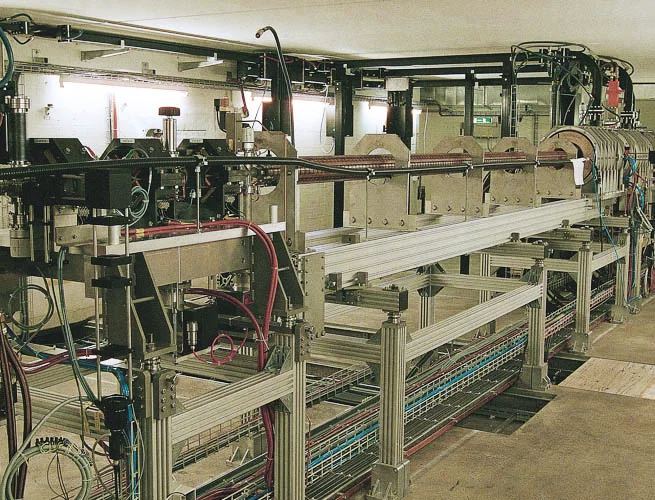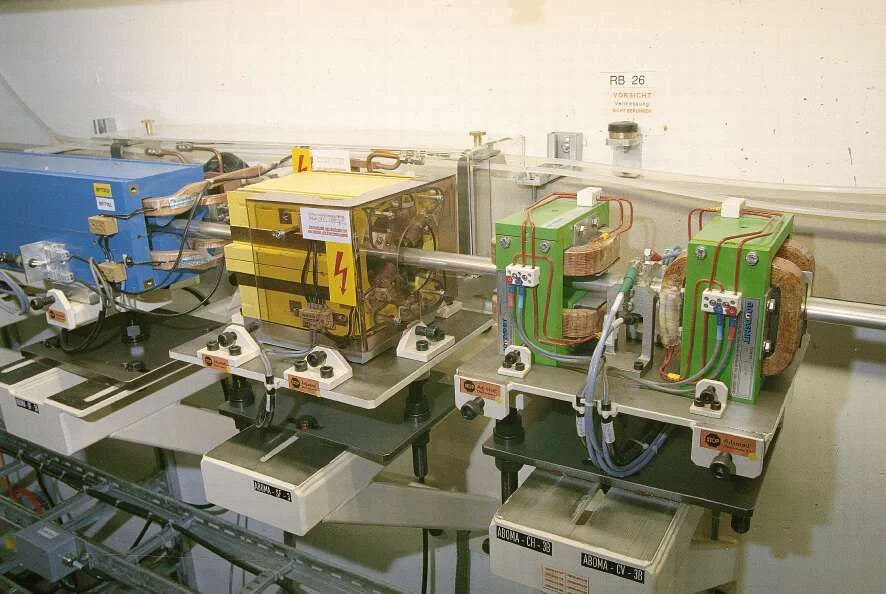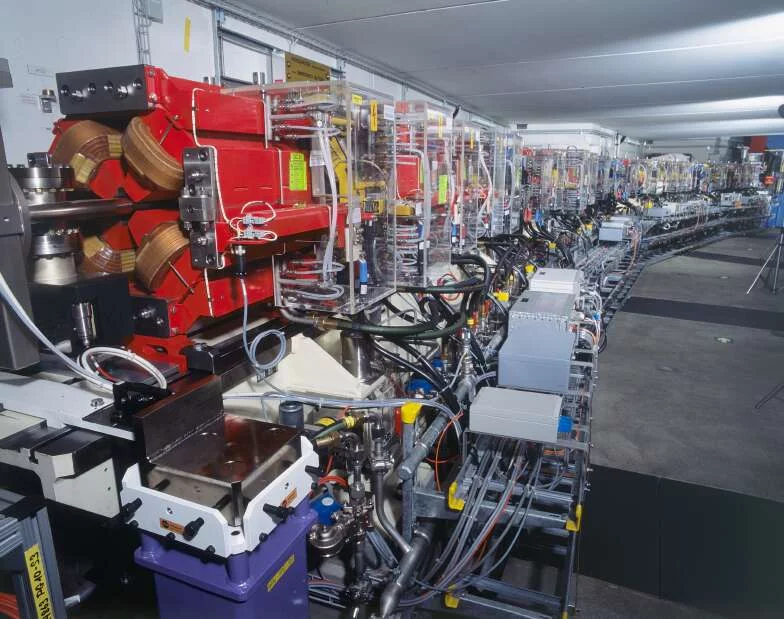An electron, deflected by a magnetic field, emits electromagnetic waves, so-called "synchrotron light". The wavelength spectrum of this radiation depends strongly on the energy of the electron. In order to generate intensive synchrotron light with a very short wavelength one needs an accelerator producing high-energy electrons.
The SLS accelerator facility consists of three major parts: a linac, a booster and a storage ring.
The linac (short for linear accelerator) pre-accelerates electrons, which are produced in an electron source, to an intermediate energy of 100 MeV.
The booster (short for booster synchrotron), accelerates the electrons, coming from the linac, to the final energy of 2.4 GeV. After extraction from the booster the electrons are then injected into the storage ring.
In the storage ring these high energy electrons circulate for hours, generating the desired synchrotron light, which in turn is used in several beam line facilities. An ultra-high vacuum inside the beam tube is necessary to avoid losses of the electrons due to collisions with air molecules.
storage ring and booster are housed in a tunnel with concrete shielding walls. Two layers of 40 cm thick concrete beams cover the tunnel and can be removed to give a crane access to the accelerator components. The linac is located in a separate tunnel.
Linear Accelerator (Linac)
The Linac consists of an electron source and two accelerating sections.
In the electron source (also called "electron gun") the electrons are pulled out of a cathode by applying a high voltage of 90 kV between cathode and anode.
The two accelerating structures are each 5.2 m long and operate at an RF frequency of 3 GHz. They increase the energy of the electrons to 100 MeV and their speed to almost the speed of light.
A 16 m long beam transport system, consisting of several magnets, guides the electrons towards the booster, into which they are injected with socalled kicker magnets. For diagnostic purposes the beam from the Linac can be deflected towards a beam dump.
The Linac has been built by the German company "ACCEL".
Booster
The Booster is a Synchrotron accelerating the electrons coming from the Linac to the final energy of 2.4 GeV. It has a circumference of 270 m and consists of a variety of itemssuch as an RF station, vacuum components, diagnostic tools and a total of 237 magnets. During acceleration the magnetic fields are constantly adapted to the corresponding energy of the electrons. After extracting the electrons from the booster the magnetic fields are then restored to their initial values. This process is periodically repeated 3 times per second. It takes then several minutes to fill the storage ring with the desired quantity of electrons (several trillions!).
At the final energy the speed of the electrons is so close to the speed of light, that in a race to the moon the light would be only 8 m ahead of the electron!
After extraction from the booster the electrons are guided in a 20 m long beam transport system towards the injection point of the storage ring.
The SLS booster is located in the same tunnel as the storage ring. It was especially designed to produce a high-quality electron beam for the so-called top-up injection. In this mode the booster injects periodically electrons into the storage ring, keeping the intensity of the circulating electron beam constant.
Storage Ring
The SLS-storage ring is a so-called "third generation light source". The second-generation facilities were designed to use the synchrotron light produced in the bending magnets. The corresponding spectrum of these electromagnetic waves (also called "photons") is continuous, and a user has to select the desired wavelength for his experiment with a filter and discard the remaining part of the spectrum. The third generation facilities, like the SLS, make use of socalled undulators. This clever device was invented in the 1970's by Klaus Halbach from the Lawrence Berkeley Laboratory in California. With permanent magnets, arranged in a periodic array, the electrons are forced to move in a slalom course. This trick concentrates the synchrotron light into discrete lines in the spectrum. The distance between each slalom turn and the strength of the magnetic field determine the desired wavelength. The effect on the character of the synchrotron light is dramatic:
- The light is emitted in a very narrow cone, similar to a laser beam; even 30m after the undulator the light spot has a diameter of only a few mm. With special mirrors the spotsize can even be reduced to less than a micron. This enables applications in microscopy and allows to examine very small samples.
- The intensity is about a factor of 1000 higher than the light from a bending magnet, with a corresponding reduction in the time needed to perform an experiment.
The SLS storage ring has a circumference of 288 m and was designed to have several straight sections of different lengths (from 4 to 11 m). One could thus incorporate a variety of undulators, covering a wide spectrum of synchrotron light from ultra-violet to hard X-rays. For the longest wavelength the magnetic field in the undulator is produced with electromagnets instead of permanent magnets.
The SLS was designed as a "state of the art" facility, producing synchrotron light of a very high quality. This required the installation of a large number of magnets - a total of 330 - to keep the diameter of the electron beam as small as possible. Special care was taken for the performance of the high- vacuum system, to guarantee a long lifetime (in the order of 10 h) of the circulating beam, ensuring very small beam losses. The synchrotron light emitted by the electrons is very intensive, corresponding to an average power of 200 kW. This power has to be refurnished to the electrons by four RF transmitters, operating at a frequency of 500 MHz.
A sophisticated diagnostic system keeps the position of the electron beam constant to less than 1 µm. This guarantees a very high stability of the photon beam on the samples to be examined.


